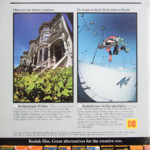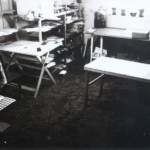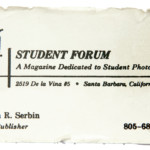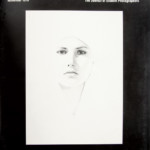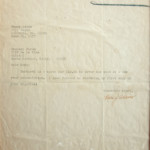Welcome to the 40th edition of Photographer’s Forum magazine.
Writing this anniversary editorial feels surreal to me in many ways. When I look back to 1977, when we published the first issue, I realize now how little I knew then about the publishing business. We were able to build a successful international publishing business that has thrived for four decades because of the support of many gifted writers, staff, photographers and industry associates who have worked with us along the way.

Publisher Glen Serbin today, 40 years ago in his first office in his apartment.
In 1976, I was 22, a recent graduate from UCLA, trying to figure out my future plans. I headed to Santa Barbara and enrolled at Brooks Institute of Photography. A fellow student agreed to invest a small sum into the concept of a black-and-white photography magazine, and Photographer’s Forum was born.
As I wrote in our 25th anniversary edition, “My relationship with Photographer’s Forum magazine was always clear and focused.… I was inspired by the European publishers who respected photography as an art form and made images the hero. I wanted to publish a magazine that showcased the best photography of both the emerging photographers and master photographers.”
In fact, it was from my mistakes that I learned the most valuable lessons.
I was excited about Photographer’s Forum (originally called Student Forum) and without any hesitation thought the best person to speak with about this new venture would be Ansel Adams. Even though he had never met me, he graciously accepted my request for an interview. Ansel was very generous with his time and advice. He cautioned against being overly optimistic because he saw so many magazines fail in his lifetime. Though he was not as excited as I was, he recommended many people for me to meet, and it was a thrill to spend time with him.

The first few years presented numerous challenges, especially advertising. During the first year in business, I literally could not get an appointment with anyone in the industry! Because I did not have publishing or business experience, very few people wanted to meet with me. In truth, everything associated with the magazine felt intimidating. My first office was my apartment, and the “staff” consisted of just myself. I made every mistake possible, but with no employees and no overhead, mistakes were not costly.
In fact, it was from my mistakes that I learned the most valuable lessons. Each error taught me something important that propelled me forward. The secret sauce of success is a blend of perseverance and making, and accepting, mistakes that you can learn by.
The first five issues of Photographer’s Forum were all black-andwhite. We lacked the funds to run color; we barely had enough money to print. Every week was a struggle to figure out how to survive. My art director, Rob Foss, was a student at CalArts (California Institute of the Arts), and he designed each issue free of charge.
During our second year, Eastman Kodak signed a contract to advertise on the back cover, a blessing of approval that carried weight with the rest of the photographic industry. With Kodak taking the lead, many of the other photographic manufacturers started to notice Photographer’s Forum.
- First color ad: From Kodak, February 1980 issue
- Serbin Communications building 2017: 5,000 sq. ft.
- First office, 1977: 150 square feet
- First business card
- First issue: Student Forum (all black-and-white)
- First subscription: June 24, 1978
I was lucky to have started the magazine in 1977. I was in the right place at the right time. During the mid-1970s, the photographic industry automated the SLR camera and the entire market grew exponentially. Consumers were now able to take photographs with a sophisticated SLR camera without having to actually know how to use it. They could simply turn the camera to Automatic and allow technology to take over.
I think the photography market in the 1970s was very similar to today’s tech industry with respect to growth, employment opportunities and explosive changes in technology.
In 1975, Steve Sasson, a Kodak employee, invented the first digital camera. Though Kodak did not figure out a way to market the first digital camera, others did, and it changed photography forever. The rise of the digital camera helped the industry grow even more. Now taking pictures was less expensive because you didn’t have to buy film and pay to have it processed. In addition, you could see your image immediately ”” which was a huge draw for the amateur photographer.
A very exciting experience was in 1987 when our staff was invited by the Soviet Union to curate one of the first Soviet photography exhibits to the United States. This was an early crack in the cold war wall between the United States and the Soviet Union.

The visit had us in the Soviet Union for three weeks as official guests of the government’s Cultural Committee. We were able to see how very different the two countries were. That adventure and the people we met will always remain a highlight for me.
In 1989, the Santa Barbara Museum of Art exhibited the show and published its companion catalog, Comrades and Cameras: Photographs from Latvia and Other Soviet Republics.
In 2010, the world again changed for the photography market. That year, the iPhone 4 came out and Instagram was born. Need I say more? As smartphones improved, more photos were snapped and shared.
Though cameras in cell phones will continue to evolve and dominate the photography market, we are currently seeing the resurgence of the traditional digital camera and interchangeable lens! According to Camera & Imaging Products Association (CIPA), the latest data available indicates that camera sales, as a whole, have begun to increase in 2017. Interchangeable lens cameras are continuing to demonstrate strong growth, with sales increasing 7.4% in April 2017 over April 2016. Sales of cameras with interchangeable bodies have increased 8.7% in 2017, compared with 2016.
As the photography market continues to evolve, I am confident that interest in creating and sharing images will also continue to grow. Photographer’s Forum now maintains a vibrant social media presence in addition to the printed magazine; our readers interact with us on Facebook, Twitter, Instagram, Tumblr and Pinterest.
Through all the changes in the photographic industry during the last 40 years, Photographer’s Forum has retained a special place in the market.
When we began, our niche was emerging photographers in college, and though this was a relatively small segment of the photography market, it was a very important one. And it remains so. The emerging photographer has always represented the future of the industry. We are very proud to have been the first publisher for so many professional photographers working today.
Our annual College and High School Photography Contest has awarded over $300,000 to emerging photographers, with more than 800 participating colleges in the United States and Canada. The Spring Photography Contest draws amateur entrants each year from more than 85 countries around the world. Photography is a universal language! We are proud to have Fujifilm and Sigma as official sponsors of our two photography contests.
Ansel was very generous with his time and advice. He cautioned against being overly optimistic.
Publishing Photographer’s Forum magazine has always been a team project, and I have been fortunate to have a dedicated and gifted team to work with over the last 40 years. Although some have passed, their contributions are a deeply valued part of our history.
My appreciation goes to Victor Rodriguez, who believed in my vision 40 years ago and provided the seed money to start the magazine.
I also want to acknowledge and thank Julie Simpson, our managing editor, who has worked so passionately on Photographer’s Forum for over two decades. Julie is a one-person band and wears many hats.
Special appreciation also goes out to our creative director, Kimberly Kavish; Karen Solomon, our advertising director; and Nell Campbell, our photo editor. Both Nell and Kimberly have each brought their unique talents to this endeavor for over 20 years!

So many people have been an important part of the Photographer’s Forum family, I really cannot list them all. That said, I do need to recognize and thank a short list of some special people. This group includes, in no particular order, Jules Wartell, George Schaub, Mehosh Dziadzio, Rob Foss, Madeline Marina, Margie Middleton, Cynthia Anderson, Valerie Witte, Mai Raack, Kim Taylor, Janice Brown, Jordan Love, Terri Wright and Tamra Dempsey. And of course, we would be nothing without our writers: Ken Lassiter, Claire Sykes, Judith Turner-Yamamoto, Lynne Eodice, Amanda Quintenz-Fiedler, Chuck Graham and Rick Benzel, among others.
With over 9,400 pages of articles published, the magazine reflects the history of photography from 1978-2017. I am proud that Photographer’s Forum magazine is officially archived by the Smithsonian Institution in Washington, D.C. The important interviews with so many master photographers working in the United States and Europe will be shared with future generations of image-makers for years to come. Thank you, Smithsonian!
I am proud that Photographer’s Forum magazine is officially archived by the Smithsonian Institution in Washington, D.C.
Serbin Communications, Inc., the publisher of Photographer’s Forum, offers commercial photographers, illustrators and art representatives a wide range of marketing vehicles ”” digitally, in print and in person. Serbin Communications is organized into four divisions: the Creative Resources Division, the Magazine Division, the Digital Resource Division and the Fine Art Photography Division. I am proud that the company has become an essential part of the creative marketing toolkit.
I have been very fortunate over the last 40 years. I hope you enjoy this 40th Anniversary edition of Photographer’s Forum magazine, and I appreciate your support and interest.
Thank you!
Glen Serbin

